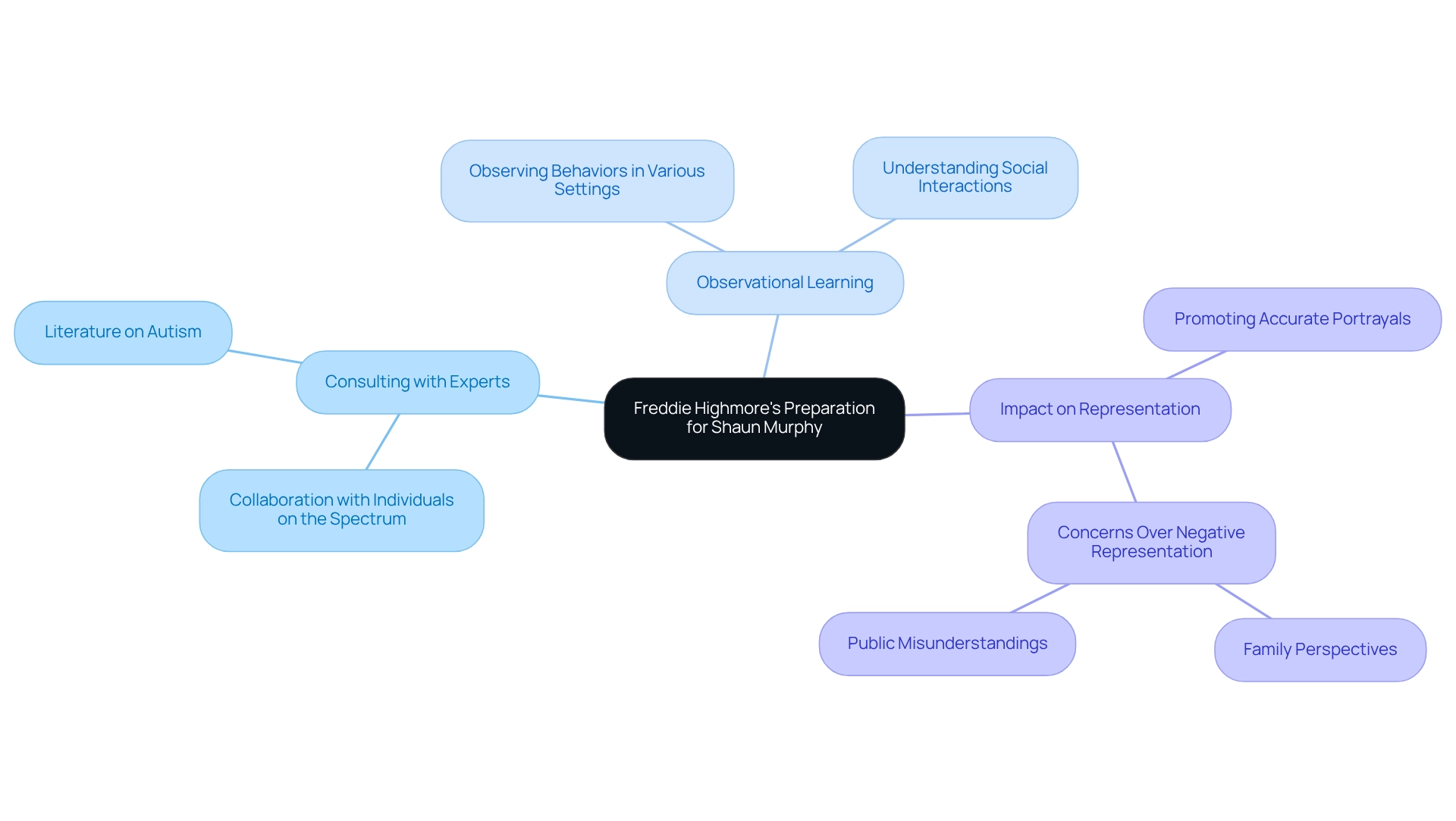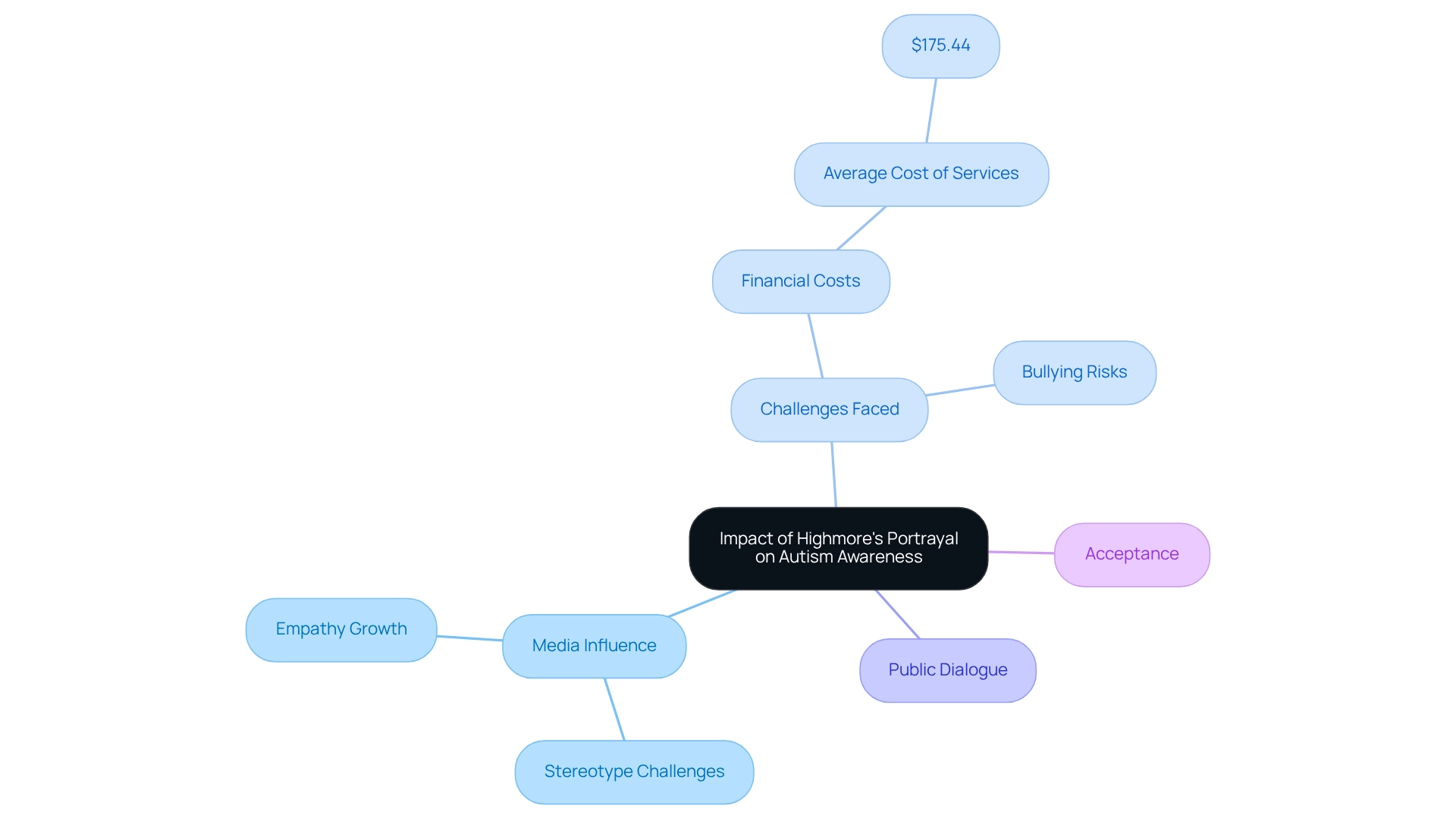Overview
Freddie Highmore's portrayal of Dr. Shaun Murphy in 'The Good Doctor' is a remarkable testament to his deep commitment to authenticity. While he is not autistic in real life, his extensive research and consultations with individuals on the autism spectrum illuminate the challenges faced by many. This dedication not only enriches his character but also plays a crucial role in enhancing awareness and acceptance of autism. By challenging stereotypes, Highmore fosters empathy within society, inviting us all to reflect on our understanding of this condition.
Imagine the impact of seeing such a nuanced representation on screen—one that resonates with both individuals on the spectrum and their families. Highmore's efforts serve as a bridge, connecting audiences to the realities of autism. As we engage with these narratives, we are encouraged to share our experiences and insights, fostering a community of support and understanding.
Let us embrace this opportunity to learn and grow together, challenging misconceptions and nurturing compassion. We can all play a part in promoting a more inclusive society, where every individual is valued and understood.
Introduction
In a world where understanding and acceptance of neurodiversity is becoming increasingly important, Freddie Highmore's portrayal of Dr. Shaun Murphy in 'The Good Doctor' shines as a transformative representation of autism. Through his commitment to authenticity and thorough preparation, Highmore not only brings depth to his character but also nurtures greater awareness of Autism Spectrum Disorder (ASD) among audiences.
This article will explore the key characteristics and challenges faced by individuals with autism, delve into Highmore's meticulous approach to embodying his role, and assess the profound impact his performance has had on public perception and acceptance of autism.
By examining these elements, we can gain a clearer understanding of how media can serve as a powerful conduit for empathy and understanding in society.
Define Autism: Key Characteristics and Challenges
Autism Spectrum Disorder (ASD) is a developmental condition that presents enduring challenges in social communication and often includes restricted, repetitive behaviors. Understanding ASD is essential for fostering compassion and support for those affected.
Individuals with ASD frequently encounter social communication difficulties. They may struggle to interpret social cues, maintain conversations, and grasp nonverbal signals, which can lead to misunderstandings in their interactions with others. This can be a source of frustration and loneliness for many.
Repetitive behaviors are another hallmark of ASD. These may manifest as repetitive movements, a strong preference for routines, or an intense focus on specific interests. Such behaviors can offer comfort and predictability in a world that often feels overwhelming.
Sensory sensitivities are also common among individuals on the spectrum. Many exhibit heightened or diminished responses to sensory inputs like sounds, lights, or textures. This sensitivity can significantly shape their daily experiences, making it crucial for caregivers and educators to understand and accommodate these needs.
The challenges faced by those with ASD extend beyond these characteristics. Many struggle to form relationships, manage anxiety, and navigate everyday social situations, often leading to feelings of isolation. Recent statistics reveal that social communication difficulties are particularly prevalent among children from lower socioeconomic backgrounds. For instance, in 2020, the Arizona site was the only ADDM Network location to meet the standard for statistical accuracy regarding AI/AN spectrum disorder prevalence, reporting a rate of 26.8 per 1,000. This underscores the urgent need for equitable access to screening and support services.
Recognizing these traits is vital for enhancing the representation of ASD in media and its influence on public perception. Experts emphasize that addressing social communication challenges is critical for improving outcomes for individuals on the autism spectrum, ensuring they receive the necessary support to thrive in their communities. Furthermore, findings from the case study titled "Equity in ASD Screening and Services" highlight the importance of equitable and accessible screening, services, and supports for all children, irrespective of their demographic background. As Autism Speaks notes, 'ABA therapy is widely acknowledged as an effective treatment for those with developmental disorders.' This emphasizes the need for effective strategies to assist individuals on the spectrum.
Let’s work together to advocate for better resources and understanding, ensuring that every child with ASD has the opportunity to flourish.
Explore Freddie Highmore's Role as Shaun Murphy: Preparation and Authenticity
Freddie's portrayal of Dr. Shaun Murphy in 'The Good Doctor' showcases a deep commitment to authenticity, requiring thoughtful preparation. Highmore took several important steps to ensure a genuine representation of autism:
- Consulting with Experts: He worked closely with consultants and individuals on the spectrum, gaining invaluable insights into their lived experiences and the challenges they face. Highmore immersed himself in literature about autism while studying the condition, which raises the question: is Freddie Highmore autistic in real life, as he explored the diverse manifestations of the condition across different individuals?
- Observational Learning: He observed those with autism in various settings, including his curiosity about whether Freddie Highmore is autistic in real life, enhancing his understanding of their behaviors and social interactions.
This dedication to authenticity enriches the character's depth and plays a vital role in promoting a more accurate representation of autism in media, which raises the question of is Freddie Highmore autistic in real life. These depictions are crucial for raising awareness and fostering understanding, especially given concerns about negative representations that can reinforce harmful stereotypes. Notably, family members often feel that Sam's portrayal resonates more closely with their experiences than individuals on the spectrum do, highlighting the varying perspectives on representations of autism among different groups. By prioritizing authenticity, Highmore contributes to a more nuanced conversation about autism, which raises the question of whether is Freddie Highmore autistic in real life, thereby bridging the gap between media portrayals and the lived experiences of the autistic community. As he noted, his friends from before his acting career help him maintain a sense of normalcy and perspective, which significantly impacts his preparation for the role. This aligns with the goal of connecting media representations with the realities faced by the autistic community, underscoring the importance of accurate representation.
As we reflect on these insights, it's essential to consider how we can support authentic portrayals in media and engage in conversations that promote understanding and compassion.

Assess the Impact of Highmore's Portrayal on Autism Awareness and Acceptance
Freddie's portrayal of Shaun Murphy in 'The Good Doctor' has significantly advanced awareness and acceptance of autism in contemporary society, prompting discussions about whether or not Freddie Highmore is autistic in real life. His character not only raises awareness but also plays a crucial role in normalizing discussions surrounding the condition. By incorporating the important topic of whether or not Freddie Highmore is autistic in real life into mainstream conversations, the actor contributes to breaking the stigma often associated with it. This nuanced portrayal effectively challenges widespread stereotypes, demonstrating the diverse experiences of individuals on the spectrum.
This representation is vital, as research indicates that children with developmental disorders are more susceptible to bullying, underscoring the need for greater understanding and acceptance. Moreover, the average cost of therapeutic behavioral services in the U.S. is $175.44, highlighting the financial challenges families face in accessing essential support, while it raises the question of whether Freddie Highmore is autistic in real life, as his relatable representation fosters compassion among viewers and prompts them to reflect on the specific challenges faced by individuals with developmental disorders.
The influence of 'The Good Doctor' extends beyond mere entertainment; it has inspired a more informed public dialogue about developmental disorders, contributing to a growing trend of acceptance. In fact, studies show that many children with ASD can achieve significant developmental milestones, reinforcing the idea that success is possible even with a diagnosis. As one study concludes, 'doing well is possible even when a child continues to meet the criteria for ASD.'
As media representations shape public perception, Highmore's role exemplifies how television can be a powerful tool for enhancing acceptance of individuals on the spectrum, prompting discussions about whether or not Freddie Highmore is autistic in real life. By confronting stereotypes and nurturing empathy, his character serves as a catalyst for change, encouraging society to embrace neurodiversity and support individuals on the spectrum. This highlights the broader influence of media portrayals in shaping public understanding and acceptance of autism.

Conclusion
Freddie Highmore's portrayal of Dr. Shaun Murphy in 'The Good Doctor' stands as a heartfelt representation of Autism Spectrum Disorder (ASD), significantly enhancing public awareness and understanding of this condition. By illustrating key characteristics of autism—such as social communication difficulties and sensory sensitivities—this portrayal sheds light on the complex challenges faced by individuals on the spectrum. Recognizing these challenges is essential for understanding how media influences societal perceptions.
Highmore's dedication to authenticity shines through his extensive preparation and collaboration with experts, enriching his character and promoting a more accurate depiction of autism. His portrayal effectively bridges the gap between media representations and the realities of those with autism, underscoring the necessity for respectful portrayals that foster empathy.
The impact of Highmore's role reaches far beyond mere entertainment; it normalizes discussions about autism and actively challenges stereotypes that contribute to stigma. By encouraging empathy, his character helps viewers appreciate the diverse experiences of individuals on the spectrum. As societal attitudes shift toward greater acceptance of neurodiversity, 'The Good Doctor' exemplifies how media can advocate for meaningful change.
In conclusion, thoughtful representations of autism in mainstream media have the power to reshape public discourse and promote acceptance. Highmore's performance illuminates the ability of media to enlighten audiences, paving the way for a more inclusive society that values the experiences of individuals with autism. This ongoing dialogue is vital for cultivating a culture of understanding and support for all on the spectrum.
Frequently Asked Questions
What is Autism Spectrum Disorder (ASD)?
Autism Spectrum Disorder (ASD) is a developmental condition characterized by ongoing challenges in social communication and often includes restricted, repetitive behaviors.
What social communication difficulties do individuals with ASD face?
Individuals with ASD often struggle to interpret social cues, maintain conversations, and understand nonverbal signals, which can lead to misunderstandings and feelings of frustration and loneliness.
What are some common repetitive behaviors associated with ASD?
Common repetitive behaviors in individuals with ASD may include repetitive movements, a strong preference for routines, and an intense focus on specific interests, providing comfort and predictability.
How do sensory sensitivities affect individuals with ASD?
Many individuals with ASD experience heightened or diminished responses to sensory inputs such as sounds, lights, or textures, significantly affecting their daily experiences.
What additional challenges do individuals with ASD encounter?
Beyond social communication difficulties, individuals with ASD may struggle to form relationships, manage anxiety, and navigate everyday social situations, often leading to feelings of isolation.
Are there disparities in the prevalence of ASD among different socioeconomic backgrounds?
Yes, social communication difficulties are particularly prevalent among children from lower socioeconomic backgrounds, highlighting the need for equitable access to screening and support services.
What does recent research indicate about ASD screening and services?
Research, including a case study titled "Equity in ASD Screening and Services," emphasizes the importance of equitable and accessible screening, services, and supports for all children, regardless of their demographic background.
What treatment is recognized as effective for individuals with developmental disorders, including ASD?
ABA (Applied Behavior Analysis) therapy is widely acknowledged as an effective treatment for individuals with developmental disorders, including those on the autism spectrum.
Why is it important to understand and recognize the traits of ASD?
Recognizing the traits of ASD is vital for enhancing representation in media and improving public perception, as well as ensuring individuals on the spectrum receive the necessary support to thrive in their communities.




